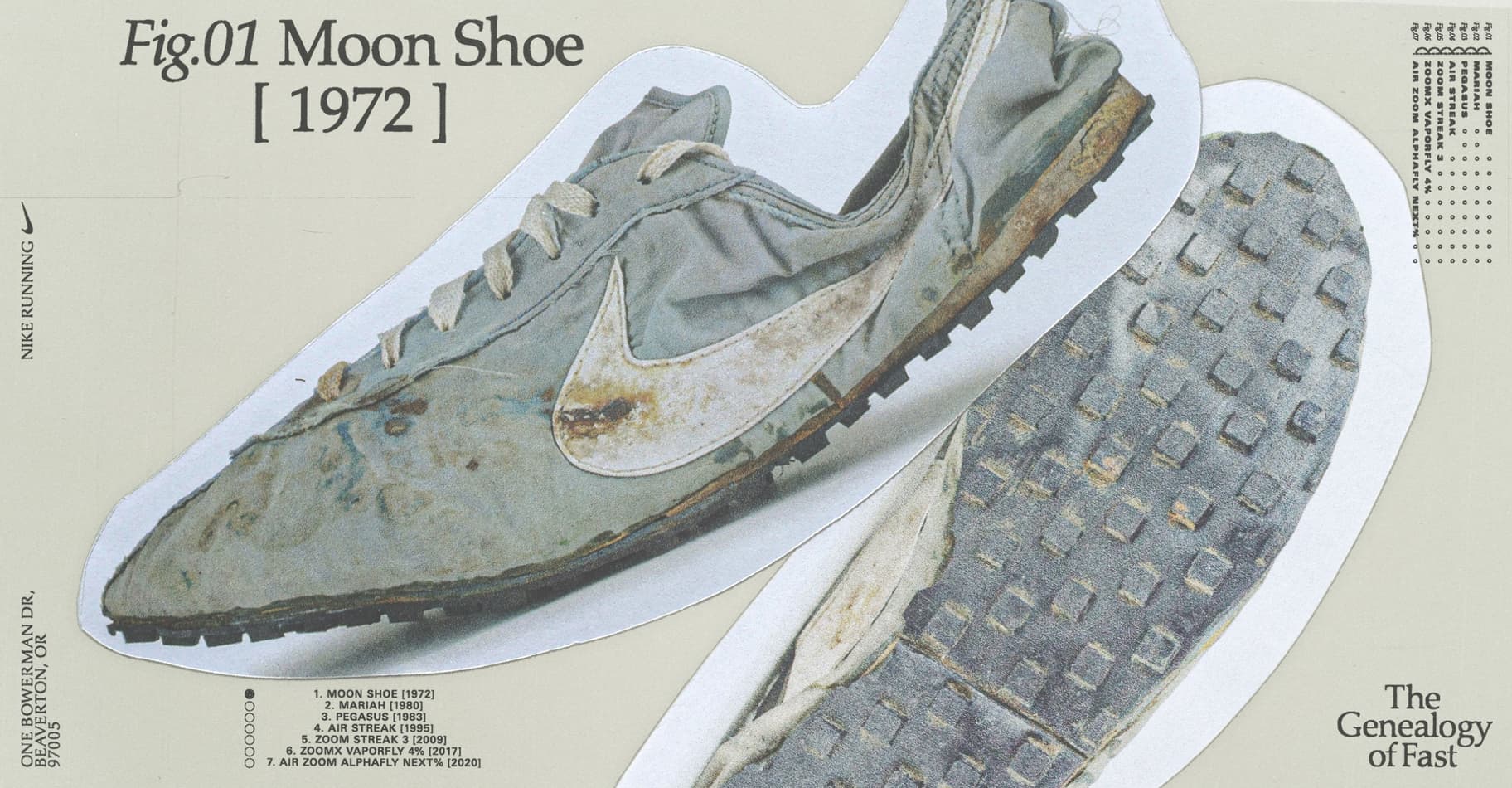This is a modal window.
Nike Running DNA: The Roots of Fast
Since the beginning, our quest has been to break barriers with cutting-edge innovations that in turn help runners break barriers. When those athletes succeed, the technology that helped them get there becomes part of the DNA we share throughout our family of footwear. We use it to improve our designs not just across running, but sometimes even in other sports. Below are some of the most pivotal and influential moments in our genealogy that have helped guide us to where we are today.

One of our early racers earned the nickname the "Moon Shoe" because many thought the prints it made on Oregon soil resembled those left on the moon by Apollo astronauts. The shoe's origins began at the breakfast table of Nike co-founder, Bill Bowerman. Bill and his wife, Barbara, were making waffles one morning and discussing Bill's pursuit in designing a shoe that was lightweight with suitable traction.
Looking at the waffle iron, Bill saw more than just the beginnings of a delicious breakfast. The outsole he used it to create became Nike's first major innovation, being both lightweight and offering great traction. These would later become two core principles for all Nike footwear. The Moon Shoe soon led to the legendary "Waffle Racer". The method for developing the iconic outsole set the mould for all innovation processes Nike still uses today: identify a problem and consider any idea to solve it.

An influential model that would move in and out of Nike's running shoe line-up for years, the Mariah was the first racing shoe to feature a full-length Air unit. The lightweight, blown-rubber outsole gave runners a cushioned ride and offered great traction on the road. The Mariah was our first shoe to offer a measurable benefit to the athlete. According to the 1985 footwear catalogue, "Tests reveal that running in the Mariah reduces energy expenditure by two percent".
Full-length Air continues to be widely used today, most notably in our Air Max line. The goal of reducing energy expenditure is a driving force behind modern Nike running innovation, one that ultimately led to our current NEXT% system.

Prior to 1983, Air was a proven technology, but was available only to elite runners. To reach the everyday runner, Nike designers were challenged with making a running shoe that had Air but was more versatile and affordable. The project began as the "Air Wedge Trainer", which put Air only in the heel where it was needed most, and soon was renamed the Pegasus.
The success of the Air wedge in the Pegasus had a reverberating effect. From the Air Jordan to football shoes, every sport category after 1983 had several shoes with Air. The wedge made the technology adaptable, and it worked. Combining an ideal price point with undeniable performance, the Pegasus has since become an industry standard with production spanning almost four decades. It alone routinely outperforms sales volumes of most of our competitors' entire lines.

The Air Streak was the first Nike running shoe (and racing flat) to feature "Tensile Air", a technology that provided snappy responsiveness by using tensile fibres woven inside a pressurised Air unit. The design of the Air Streak was inspired by working with elite Japanese runners, and combined flexibility and comfort for a great ride that was both lightweight and felt like a training shoe.
In 1996, Tensile Air was renamed "Zoom Air", and has proven to be among the most pivotal technologies used by Nike across sport categories. It's a vital component critical to the success of our fastest racing shoes like the Alphafly NEXT%, trusted by athletes who competed at the games in Tokyo.

A favourite among elite runners from 2009 to 2013, the Zoom Streak 3 crossed more finishing lines than any other Nike racing flat prior to its debut. The upper in particular was unique and highly innovative for the time, consisting of a single piece of open mesh that offered exceptional breathability and rapid water drainage without adding weight.
Lightweight, flexible, responsive and quick in transition, the Zoom Streak 3 would prove to be an inspiration to the team working on the groundbreaking Vaporfly project.

Building on the success of prototypes, the Zoom Vaporfly 4% was the first commercially available Nike racing shoe to utilise a revolutionary midsole system. Consisting of lightweight, resilient Zotefoam (which became ZoomX) and a stiff carbon fibre plate, this combination improved running economy by an amazing 4%, research indicated.
In 2018, elite Kenyan runner Eliud Kipchoge broke the men's world record for the marathon wearing the 4%%s. With its pioneering tech and propulsive ride, the Zoom Vaporfly 4% effectively changed running forever, informing the Nike Zoom Fly, Tempo and Alphafly NEXT%, not to mention every competitor in the game.

The Alphafly NEXT% is the pinnacle of Nike running innovation. Borrowing learnings and technology from the Vaporfly 4% as well as the Vaporfly NEXT%, the Alphafly added twin Zoom Air pods beneath the forefoot and even more ZoomX foam in the heel, making it one of the most anticipated running shoes in history.
After some argued that the technology gives runners an unfair advantage, the global governing body that decides what is permitted in racing changed its rules to say that all shoes in races had to be commercially available for at least four months prior to race day.
The Road Ahead
Innovation informed by and in service of athletes will always be at the heart of how we move forward. The learnings and breakthroughs that come from this exploration become the DNA that informs all our future efforts to empower those who push the limits of human potential.